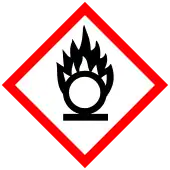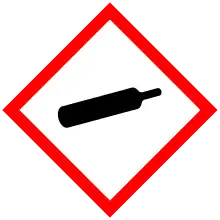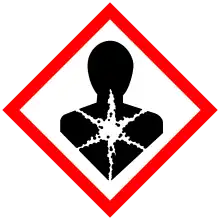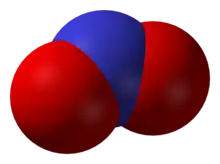| |||
 NO 2 converts to the colorless dinitrogen tetroxide (N 2O 4) at low temperatures and reverts to NO 2 at higher temperatures. | |||
| Names | |||
|---|---|---|---|
| IUPAC name
Nitrogen dioxide | |||
| Other names
Nitrogen(IV) oxide,[1] deutoxide of nitrogen | |||
| Identifiers | |||
3D model (JSmol) |
|||
| ChEBI | |||
| ChemSpider | |||
| ECHA InfoCard | 100.030.234 | ||
| EC Number |
| ||
| 976 | |||
PubChem CID |
|||
| RTECS number |
| ||
| UNII | |||
| UN number | 1067 | ||
CompTox Dashboard (EPA) |
|||
| |||
| |||
| Properties | |||
| NO• 2 | |||
| Molar mass | 46.005 g·mol−1 | ||
| Appearance | Brown gas[2] | ||
| Odor | Chlorine-like | ||
| Density | 1.880 g/L[2] | ||
| Melting point | −9.3 °C (15.3 °F; 263.8 K)[2] | ||
| Boiling point | 21.15 °C (70.07 °F; 294.30 K)[2] | ||
| Hydrolyses | |||
| Solubility | Soluble in CCl 4, nitric acid,[3] chloroform | ||
| Vapor pressure | 98.80 kPa (at 20 °C) | ||
| +150.0·10−6 cm3/mol[4] | |||
Refractive index (nD) |
1.449 (at 20 °C) | ||
| Structure | |||
| C2v | |||
| Bent | |||
| Thermochemistry[5] | |||
Heat capacity (C) |
37.2 J/(mol·K) | ||
Std molar entropy (S⦵298) |
240.1 J/(mol·K) | ||
Std enthalpy of formation (ΔfH⦵298) |
+33.2 kJ/mol | ||
| Hazards | |||
| Occupational safety and health (OHS/OSH): | |||
Main hazards |
Poison, oxidizer | ||
| GHS labelling: | |||
     | |||
| Danger | |||
| H270, H314, H330 | |||
| P220, P260, P280, P284, P305+P351+P338, P310 | |||
| NFPA 704 (fire diamond) | |||
| Lethal dose or concentration (LD, LC): | |||
LC50 (median concentration) |
30 ppm (guinea pig, 1 h) 315 ppm (rabbit, 15 min) 68 ppm (rat, 4 h) 138 ppm (rat, 30 min) 1000 ppm (mouse, 10 min)[6] | ||
LCLo (lowest published) |
64 ppm (dog, 8 h) 64 ppm (monkey, 8 h)[6] | ||
| NIOSH (US health exposure limits): | |||
PEL (Permissible) |
C 5 ppm (9 mg/m3)[7] | ||
REL (Recommended) |
ST 1 ppm (1.8 mg/m3)[7] | ||
IDLH (Immediate danger) |
13 ppm[7] | ||
| Safety data sheet (SDS) | ICSC 0930 | ||
| Related compounds | |||
Related nitrogen oxides |
Dinitrogen pentoxide Dinitrogen tetroxide | ||
Related compounds |
Chlorine dioxide Carbon dioxide | ||
Except where otherwise noted, data are given for materials in their standard state (at 25 °C [77 °F], 100 kPa).
Infobox references | |||
Nitrogen dioxide is a chemical compound with the formula NO2. One of several nitrogen oxides, nitrogen dioxide is a reddish-brown gas. It is a paramagnetic, bent molecule with C2v point group symmetry. Industrially, NO2 is an intermediate in the synthesis of nitric acid, millions of tons of which are produced each year, primarily for the production of fertilizers.
Nitrogen dioxide is poisonous and can be fatal if inhaled in large quantities.[8] The LC50 (median lethal dose) for humans has been estimated to be 174 ppm for a 1-hour exposure.[9] It is also included in the NOx family of atmospheric pollutants.
Properties
Nitrogen dioxide is a reddish-brown gas with a pungent, acrid odor above 21.2 °C (70.2 °F; 294.3 K) and becomes a yellowish-brown liquid below 21.2 °C (70.2 °F; 294.3 K). It forms an equilibrium with its dimer, dinitrogen tetroxide (N2O4), and converts almost entirely to N2O4 below −11.2 °C (11.8 °F; 261.9 K).[7]
The bond length between the nitrogen atom and the oxygen atom is 119.7 pm. This bond length is consistent with a bond order between one and two.
Unlike ozone (O3) the ground electronic state of nitrogen dioxide is a doublet state, since nitrogen has one unpaired electron,[10] which decreases the alpha effect compared with nitrite and creates a weak bonding interaction with the oxygen lone pairs. The lone electron in NO2 also means that this compound is a free radical, so the formula for nitrogen dioxide is often written as •NO2.
The reddish-brown color is a consequence of preferential absorption of light in the blue region of the spectrum (400–500 nm), although the absorption extends throughout the visible (at shorter wavelengths) and into the infrared (at longer wavelengths). Absorption of light at wavelengths shorter than about 400 nm results in photolysis (to form NO + O, atomic oxygen); in the atmosphere the addition of the oxygen atom so formed to O2 results in ozone.
Preparation
Nitrogen dioxide typically arises via the oxidation of nitric oxide by oxygen in air (e.g. as result of corona discharge):[11]
- NO + 1⁄2 O2 → NO2
Nitrogen dioxide is formed in most combustion processes using air as the oxidant. At elevated temperatures nitrogen combines with oxygen to form nitrogen dioxide:
- 1⁄2 N2 + O2 → NO2
In the laboratory, NO
2 can be prepared in a two-step procedure where dehydration of nitric acid produces dinitrogen pentoxide:
- 2 HNO3 → N2O5 + H2O
- 6 HNO3 + 1⁄2 P4O10 → 3 N2O5 + 2 H3PO4
which subsequently undergoes thermal decomposition:
- N2O5 → 2 NO2 + 1⁄2 O2
The thermal decomposition of some metal nitrates also generates NO2:
- Pb(NO3)2 → PbO + 2 NO2 + 1⁄2 O2
NO2 is generated by the reduction of concentrated nitric acid with a metal (such as copper):
- 4 HNO3 + Cu → Cu(NO3)2 + 2 NO2 + 2 H2O
Formation from decomposition of nitric acid
Nitric acid decomposes slowly to nitrogen dioxide by the overall reaction:
- 2 HNO3 → 2 NO2 + H2O + 1⁄2 O2
The nitrogen dioxide so formed confers the characteristic yellow color often exhibited by this acid.
Selected reactions
Thermal properties
NO2 exists in equilibrium with the colourless gas dinitrogen tetroxide (N2O4):
- 2 NO2 ⇌ N2O4
The equilibrium is characterized by ΔH = −57.23 kJ/mol, which is exothermic. NO2 is favored at higher temperatures, while at lower temperatures, N2O4 predominates. N2O4 can be obtained as a white solid with melting point −11.2 °C.[11] NO2 is paramagnetic due to its unpaired electron, while N2O4 is diamagnetic.
At 150 °C (302 °F; 423 K), NO2 decomposes with release of oxygen via an endothermic process (ΔH = 14 kJ/mol):
- NO2 → NO + 1⁄2 O2
As an oxidizer
As suggested by the weakness of the N–O bond, NO2 is a good oxidizer. Consequently, it will combust, sometimes explosively, in the presence of hydrocarbons.
Hydrolysis
NO2 reacts with water to give nitric acid and nitrous acid:
- 2 NO2 + H2O → HNO2 + HNO3
This reaction is one of the steps in the Ostwald process for the industrial production of nitric acid from ammonia.[12] This reaction is negligibly slow at low concentrations of NO2 characteristic of the ambient atmosphere, although it does proceed upon NO2 uptake to surfaces. Such surface reaction is thought to produce gaseous HNO2 (often written as HONO) in outdoor and indoor environments.[13]
Conversion to nitrates
NO2 is used to generate anhydrous metal nitrates from the oxides:[11]
- MO + 3 NO2 → M(NO3)2 + NO
Alkyl and metal iodides give the corresponding nitrates:[10]
- TiI4 + 8 NO2 → Ti(NO3)4 + 4 NO + 2 I2
Ecology
NO2 is introduced into the environment by natural causes, including entry from the stratosphere, bacterial respiration, volcanos, and lightning. These sources make NO2 a trace gas in the atmosphere of Earth, where it plays a role in absorbing sunlight and regulating the chemistry of the troposphere, especially in determining ozone concentrations.[14]
Uses
NO2 is used as an intermediate in the manufacturing of nitric acid, as a nitrating agent in the manufacturing of chemical explosives, as a polymerization inhibitor for acrylates, as a flour bleaching agent,[15]: 223 and as a room temperature sterilization agent.[16] It is also used as an oxidizer in rocket fuel, for example in red fuming nitric acid; it was used in the Titan rockets, to launch Project Gemini, in the maneuvering thrusters of the Space Shuttle, and in uncrewed space probes sent to various planets.[17]
Human-caused sources and exposure

For the general public, the most prominent sources of NO2 are internal combustion engines, as combustion temperatures are high enough to thermally combine some of the nitrogen and oxygen in the air to form NO2.[8] Outdoors, NO2 can be a result of traffic from motor vehicles.[18]
Indoors, exposure arises from cigarette smoke,[19] and butane and kerosene heaters and stoves.[20]
Workers in industries where NO2 is used are also exposed and are at risk for occupational lung diseases, and NIOSH has set exposure limits and safety standards.[7] Workers in high voltage areas especially those with spark or plasma creation are at risk. Agricultural workers can be exposed to NO2 arising from grain decomposing in silos; chronic exposure can lead to lung damage in a condition called "silo-filler's disease".[21][22]
Toxicity
NO2 diffuses into the epithelial lining fluid (ELF) of the respiratory epithelium and dissolves. There, it chemically reacts with antioxidant and lipid molecules in the ELF. The health effects of NO2 are caused by the reaction products or their metabolites, which are reactive nitrogen species and reactive oxygen species that can drive bronchoconstriction, inflammation, reduced immune response, and may have effects on the heart.[23]


Acute harm due to NO2 exposure is rare. 100–200 ppm can cause mild irritation of the nose and throat, 250–500 ppm can cause edema, leading to bronchitis or pneumonia, and levels above 1000 ppm can cause death due to asphyxiation from fluid in the lungs. There are often no symptoms at the time of exposure other than transient cough, fatigue or nausea, but over hours inflammation in the lungs causes edema.[24][25]
For skin or eye exposure, the affected area is flushed with saline. For inhalation, oxygen is administered, bronchodilators may be administered, and if there are signs of methemoglobinemia, a condition that arises when nitrogen-based compounds affect the hemoglobin in red blood cells, methylene blue may be administered.[26][27]
It is classified as an extremely hazardous substance in the United States as defined in Section 302 of the U.S. Emergency Planning and Community Right-to-Know Act (42 U.S.C. 11002), and it is subject to strict reporting requirements by facilities which produce, store, or use it in significant quantities.[28]
Health effects of NO2 exposure
Exposure to low levels of NO2 over time can cause changes in lung function.[29] Chronic exposure to NO2 can cause respiratory effects including airway inflammation in healthy people and increased respiratory symptoms in people with asthma.
The effects of toxicity on health have been examined using questionnaires and in-person interviews in an effort to understand the relationship between NO2 and asthma. The influence of indoor air pollutants on health is important because the majority of people in the world spend more than 80% of their time indoors.[30] The amount of time spent indoors depends upon on several factors including geographical region, job activities, and gender among other variables. Additionally, because home insulation is improving, this can result in greater retention of indoor air pollutants, such as NO2.[30] With respect to geographic region, the prevalence of asthma has ranged from 2 to 20% with no clear indication as to what's driving the difference.[30] This may be a result of the "hygiene hypothesis" or "western lifestyle" that captures the notions of homes that are well insulated and with fewer inhabitants.[30] Another study examined the relationship between nitrogen exposure in the home and respiratory symptoms and found a statistically significant odds ratio of 2.23 (95% CI: 1.06, 4.72) among those with a medical diagnosis of asthma and gas stove exposure.[31]
A major source of indoor exposure to NO2 is the use of gas stoves for cooking or heating in homes. According to the 2000 census, over half of US households use gas stoves[32] and indoor exposure levels of NO2 are, on average, at least three times higher in homes with gas stoves compared to electric stoves with the highest levels being in multifamily homes. Exposure to NO2 is especially harmful for children with asthma. Research has shown that children with asthma who live in homes with gas stoves have greater risk of respiratory symptoms such as wheezing, cough and chest tightness.[31][33] Additionally, gas stove use was associated with reduced lung function in girls with asthma, although this association was not found in boys.[34] Using ventilation when operating gas stoves may reduce the risk of respiratory symptoms in children with asthma.
In a cohort study with inner-city minority African American Baltimore children to determine if there was a relationship between NO2 and asthma for children aged 2 to 6 years old, with an existing medical diagnosis of asthma, and one asthma related visit, families of lower socioeconomic status were more likely to have gas stoves in their homes. The study concluded that higher levels of NO2 within a home were linked to a greater level of respiratory symptoms among the study population. This further exemplifies that NO
2 toxicity is dangerous for children.[35]
Environmental effects
Interaction of NO2 and other NOx with water, oxygen and other chemicals in the atmosphere can form acid rain which harms sensitive ecosystems such as lakes and forests.[36] Elevated levels of NO
2 can also harm vegetation, decreasing growth, and reduce crop yields.[37]
See also
- Dinitrogen tetroxide
- Nitric oxide (NO) – pollutant that is short lived because it converts to NO2 in the presence of ozone
- Nitrite
- Nitrous oxide (N2O) – "laughing gas", a linear molecule, isoelectronic with CO2 but with a nonsymmetric arrangement of atoms (NNO)
- Nitryl
References
- ↑ "nitrogen dioxide (CHEBI:33101)". Chemical Entities of Biological Interest (ChEBI). UK: European Bioinformatics Institute. 13 January 2008. Main. Archived from the original on 4 March 2016. Retrieved 4 October 2011.
- 1 2 3 4 Haynes, 4.79.
- ↑ Mendiara, S. N.; Sagedahl, A.; Perissinotti, L. J. (2001). "An electron paramagnetic resonance study of nitrogen dioxide dissolved in water, carbon tetrachloride and some organic compounds". Applied Magnetic Resonance. 20 (1–2): 275–287. doi:10.1007/BF03162326. S2CID 97875925.
- ↑ Haynes, 4.134.
- ↑ Haynes, 5.16.
- 1 2 "Nitrogen dioxide". Immediately Dangerous to Life or Health Concentrations (IDLH). National Institute for Occupational Safety and Health (NIOSH).
- 1 2 3 4 5 NIOSH Pocket Guide to Chemical Hazards. "Nitrogen dioxide". National Institute for Occupational Safety and Health (NIOSH).
- 1 2
 This article incorporates public domain material from Nitrogen dioxide. United States Environmental Protection Agency. Feb 23, 2016.
This article incorporates public domain material from Nitrogen dioxide. United States Environmental Protection Agency. Feb 23, 2016.
- ↑ "Immediately Dangerous to Life or Health Concentrations (IDLH): Nitrogen dioxide". The National Institute for Occupational Safety and Health (NIOSH). May 1994. Retrieved October 20, 2023.
- 1 2 Greenwood, Norman N.; Earnshaw, Alan (1997). Chemistry of the Elements (2nd ed.). Butterworth-Heinemann. p. 455-7. ISBN 978-0-08-037941-8.
- 1 2 3 Holleman, A. F.; Wiberg, E. (2001) Inorganic Chemistry. Academic Press: San Diego. ISBN 0-12-352651-5.
- ↑ Thiemann, Michael; Scheibler, Erich; Wiegand, Karl Wilhelm (2005). "Nitric Acid, Nitrous Acid, and Nitrogen Oxides". Ullmann's Encyclopedia of Industrial Chemistry. Weinheim: Wiley-VCH. doi:10.1002/14356007.a17_293. ISBN 978-3-527-30673-2.
- ↑ Finlayson-Pitts, B. J.; Wingen, L. M.; Sumner, A. L.; Syomin, D.; Ramazan, K. A. (2002-12-16). "The heterogeneous hydrolysis of NO2 in laboratory systems and in outdoor and indoor atmospheres: An integrated mechanism" (PDF). Physical Chemistry Chemical Physics. 5 (2): 223–242. doi:10.1039/B208564J.
- ↑ WHO Air Quality Guidelines – Second Edition. Chapter 7.1 Nitrogen Dioxide.
- ↑ Subcommittee on Emergency and Continuous Exposure Guidance Levels for Selected Submarine Contaminants; Committee on Toxicology; Board on Environmental Studies and Toxicology; Division on Earth and Life Studies; National Research Council. Chapter 12: Nitrogen Dioxide in Emergency and Continuous Exposure Guidance Levels for Selected Submarine Contaminants. National Academies Press, 2007. ISBN 978-0-309-09225-8
- ↑ "Mechanism Overview, June 2012" (PDF). noxilizer.com. Noxilizer, Inc. Archived from the original (PDF) on 12 April 2016. Retrieved 2 July 2013.
- ↑ Cotton, Simon (21 March 2013) Nitrogen dioxide. RSC Chemistry World.
- ↑ "Air quality guidelines – global update 2005". WHO. Archived from the original on March 9, 2014. Retrieved 2016-10-19.
- ↑ US Dept. of Health and Human Services, Public Health Service, Agency for Toxic Substances and Disease Registry, Division of Toxicology. April 2002 ATSDR Nitrous Oxides.
- ↑ "The Impact of Unvented Gas Heating Appliances on Indoor Nitrogen Dioxide Levels in 'TIGHT' Homes" (PDF). ahrinet.org. 2013-03-21. Archived from the original (PDF) on 2020-08-05. Retrieved 2018-09-25.
- ↑ Chan-Yeung, M.; Ashley, M. J.; Grzybowski, S. (1978). "Grain dust and the lungs". Canadian Medical Association Journal. 118 (10): 1271–4. PMC 1818652. PMID 348288.
- ↑ Gurney, J. W.; Unger, J. M.; Dorby, C. A.; Mitby, J. K.; von Essen, S. G. (1991). "Agricultural disorders of the lung". Radiographics. 11 (4): 625–34. doi:10.1148/radiographics.11.4.1887117. PMID 1887117.
- 1 2 U.S. EPA. Integrated Science Assessment for Oxides of Nitrogen – Health Criteria (2016 Final Report). U.S. Environmental Protection Agency, Washington, DC, EPA/600/R-15/068, 2016. Federal Register Notice Jan 28, 2016 Free download available at Report page at EPA website.
- ↑ Toxnet Nitrogen dioxide: Human Health Effects Page accessed March 28, 2016.
- ↑ CDC NIOSH International Chemical Safety Cards (ICSC): Nitrogen Dioxide Page last reviewed: July 22, 2015; Page last updated: July 1, 2014.
- ↑ Agency for Toxic Substances and Disease Registry via the CDC Medical Management Guidelines for Nitrogen Oxides Page last reviewed: October 21, 2014; Page last updated: October 21, 2014
- ↑ University of Kansas Hospital, Poison Control Center Poison Facts: Medium Chemicals: Nitrogen Dioxide Archived 2016-04-11 at the Wayback Machine page accessed March 28, 2016
- ↑ "40 C.F.R.: Appendix A to Part 355—The List of Extremely Hazardous Substances and Their Threshold Planning Quantities" (PDF) (July 1, 2008 ed.). Government Printing Office. Archived from the original (PDF) on February 25, 2012. Retrieved October 29, 2011.
- ↑ Int Panis, L (2017). "Short-term air pollution exposure decreases lung function: a repeated measures study in healthy adults". Environmental Health. 16 (1): 60. doi:10.1186/s12940-017-0271-z. PMC 5471732. PMID 28615020.
- 1 2 3 4 Heinrich, Joachim (2011-01-01). "Influence of indoor factors in dwellings on the development of childhood asthma". International Journal of Hygiene and Environmental Health. 214 (1): 1–25. doi:10.1016/j.ijheh.2010.08.009. PMID 20851050.
- 1 2 Garrett, Maria H.; Hooper, Martin A.; Hooper, Beverley M.; Abramson, Michael J. (1998-09-01). "Respiratory Symptoms in Children and Indoor Exposure to Nitrogen Dioxide and Gas Stoves" (PDF). American Journal of Respiratory and Critical Care Medicine. 158 (3): 891–895. doi:10.1164/ajrccm.158.3.9701084. PMID 9731022.
- ↑ "Historical Census of Housing Tables -House Heating Fuel". www.census.gov. Retrieved 2016-10-19.
- ↑
 This article incorporates public domain material from Nitrogen Dioxide Basic Information. United States Environmental Protection Agency. Retrieved February 23, 2016.
This article incorporates public domain material from Nitrogen Dioxide Basic Information. United States Environmental Protection Agency. Retrieved February 23, 2016.
- ↑ Chapman, Robert S.; Hadden, Wilbur C.; Perlin, Susan A. (2003-07-15). "Influences of asthma and household environment on lung function in children and adolescents: the third national health and nutrition examination survey". American Journal of Epidemiology. 158 (2): 175–189. doi:10.1093/aje/kwg129. PMID 12851231.
- ↑ Hansel, Nadia N.; Breysse, Patrick N.; McCormack, Meredith C.; Matsui, Elizabeth C.; Curtin-Brosnan, Jean; Williams, D'Ann L.; Moore, Jennifer L.; Cuhran, Jennifer L.; Diette, Gregory B. (2016-10-19). "A Longitudinal Study of Indoor Nitrogen Dioxide Levels and Respiratory Symptoms in Inner-City Children with Asthma". Environmental Health Perspectives. 116 (10): 1428–1432. doi:10.1289/ehp.11349. PMC 2569107. PMID 18941590.
- ↑ US EPA, OAR (2016-07-06). "Basic Information about NO2". US EPA. Retrieved 2020-07-03.
- ↑ "Nitrogen oxides". Queensland Government. Retrieved 2020-07-03.
Cited sources
- Haynes, William M., ed. (2011). CRC Handbook of Chemistry and Physics (92nd ed.). CRC Press. ISBN 978-1-4398-5511-9.
External links
- International Chemical Safety Card 0930
- National Pollutant Inventory – Oxides of nitrogen fact sheet
- NIOSH Pocket Guide to Chemical Hazards
- WHO-Europe reports: Health Aspects of Air Pollution (2003) (PDF) and "Answer to follow-up questions from CAFE (2004) (PDF)
- Nitrogen Dioxide Air Pollution
- Current global map of nitrogen dioxide distribution
- A review of the acute and long term impacts of exposure to nitrogen dioxide in the United Kingdom IOM Research Report TM/04/03


